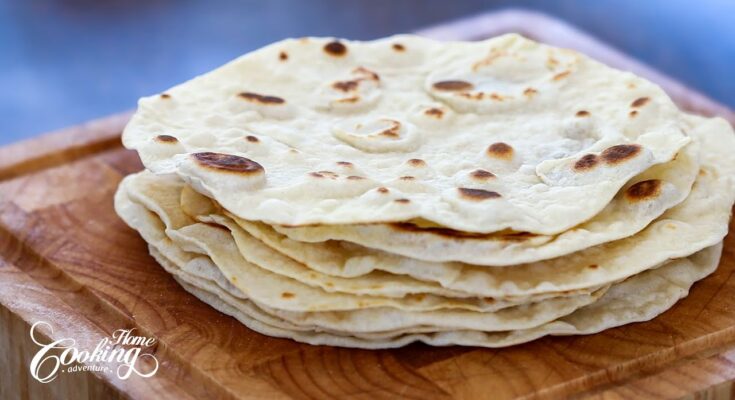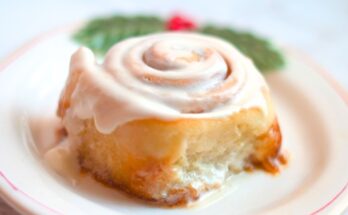Tortillas Recipe: Tortillas are a staple in many kitchens, especially in Mexican and Central American cuisine. Thin, round, and incredibly versatile, these flatbreads serve as the base for countless dishes—from tacos and burritos to enchiladas and quesadillas. What makes tortillas so beloved is their simplicity and adaptability. Made with just a handful of ingredients, they can be whipped up quickly, yet they pack a rich taste and a satisfying texture. Whether you’re into flour or corn versions, tortillas have a universal appeal that makes them perfect for breakfast, lunch, dinner, or even as a snack.
Homemade tortillas offer a flavor and freshness that store-bought ones just can’t match. Plus, making them yourself allows for complete control over ingredients, ensuring they’re as healthy or indulgent as you like. Want gluten-free? Use masa harina. Prefer something fluffier? Opt for all-purpose flour and a bit of baking powder. There’s a tortilla for every palate.
History and Cultural Significance
Tortillas date back thousands of years to ancient Mesoamerica, where indigenous people used maize (corn) as a staple ingredient in their diet. Corn tortillas, the original form, were a daily part of life for the Aztecs and Mayans. They were often used to scoop food, wrap fillings, or eat on their own. Flour tortillas came later, introduced after the Spanish conquest, using wheat brought from Europe.
Over time, tortillas evolved into a culinary canvas across Latin America and the United States. Today, they’re not just traditional food—they’re cultural symbols. In Mexican homes, the aroma of freshly made tortillas signals comfort and togetherness. Across the globe, they’ve found a place in fusion dishes and health-conscious recipes, demonstrating their global popularity and timeless appeal.
Ingredients for Homemade Tortillas
Essential Ingredients
You don’t need a long grocery list to make tortillas. In fact, most of the ingredients are likely already in your kitchen. Here’s what you’ll typically need for each type:
For Corn Tortillas:
- 2 cups masa harina (corn flour)
- 1 1/2 cups warm water
- 1/2 tsp salt
For Flour Tortillas:
- 2 cups all-purpose flour
- 1/2 tsp salt
- 3 tbsp vegetable oil or lard
- 3/4 cup warm water
The ingredients are humble, but the results are extraordinary. Masa harina gives corn tortillas their distinctive, earthy flavor. For flour tortillas, fat (like oil or lard) is essential for that soft, chewy texture. Always use warm water to help the dough come together easily.
Variations (Corn vs. Flour Tortillas)
The major difference between corn and flour tortillas lies in their base ingredient—and that changes everything from flavor to texture to nutritional content.
Corn Tortillas:
- Naturally gluten-free
- Earthy, rustic flavor
- Slightly thicker and more delicate
- Ideal for tacos, enchiladas, and tostadas
Flour Tortillas:
- Soft and pliable
- Neutral flavor
- Better suited for burritos, wraps, and quesadillas
Some modern recipes mix both corn and wheat flours to achieve a balanced taste and texture. Others might include herbs, spices, or even vegetables like spinach for a creative twist.
Tools You’ll Need
Kitchen Equipment for Making Tortillas
While tortillas can be made by hand, having the right tools can make the process smoother and more efficient. Here’s what you’ll want on your countertop:
- Mixing bowl: For combining ingredients
- Rolling pin: Essential for flattening flour tortilla dough
- Tortilla press: Especially useful for corn tortillas
- Cast iron skillet or griddle: Ideal for cooking evenly
- Clean towel or tortilla warmer: To keep cooked tortillas soft and warm
Don’t worry if you don’t have a tortilla press—you can always use a flat-bottomed pan or plate to press your dough. Likewise, any sturdy skillet will work for cooking, though cast iron gives you those authentic, slightly crispy edges.
Step-by-Step Guide to Making Tortillas
Step 1: Mixing the Dough
Start by combining your dry ingredients in a large bowl. For corn tortillas, this means masa harina and salt. For flour tortillas, combine flour, salt, and baking powder (if using), then add the fat—either lard, butter, or oil—and mix until crumbly.
Slowly add warm water, mixing with your hands until a soft dough forms. The dough should be smooth but not sticky. If it feels dry, add a tablespoon of water at a time. If it’s too wet, sprinkle in more flour or masa.
This step is all about feel. Don’t overthink it—knead until the dough becomes pliable and slightly elastic. Once you get the texture right, you’re already halfway to tortilla greatness.
Step 2: Resting the Dough
Letting the dough rest is crucial. Cover it with a damp cloth or plastic wrap and allow it to sit for 20–30 minutes. This helps the gluten (in flour tortillas) relax and makes rolling or pressing easier. For corn tortillas, it helps hydrate the masa fully, improving texture and flexibility.
Skipping this step might leave you with stiff or hard-to-roll dough—definitely not what you want when aiming for soft, pillowy tortillas. Consider this a breather for both you and the dough!
Step 3: Dividing and Rolling the Dough
Now that your dough is well-rested, it’s time to divide and roll it out. Start by separating the dough into small, equal-sized balls—each should be about the size of a golf ball. If you’re making flour tortillas, this yields about 8–10 medium-sized pieces. For corn tortillas, you may get a few more since they tend to be smaller in diameter.
For Flour Tortillas:
- Lightly flour your work surface.
- Use a rolling pin to roll each ball into a thin circle, around 6 to 8 inches in diameter.
- Try to keep them evenly shaped, but don’t worry if they’re not perfect—homemade charm goes a long way!
For Corn Tortillas:
- Place the dough ball between two sheets of plastic or parchment paper.
- Use a tortilla press to flatten it out.
- If you don’t have a press, a heavy skillet or even your hands can do the job.
Pro tip: Don’t stack uncooked tortillas on top of each other; they’ll stick. Use wax paper to separate them if you’re prepping ahead.
Step 4: Cooking the Tortillas
Time to bring your tortillas to life! Heat a dry cast iron skillet or griddle over medium-high heat. You want it hot but not smoking.
Place a tortilla on the skillet and let it cook for about 30 seconds to 1 minute on the first side. You’ll know it’s ready to flip when you see bubbles forming and slight browning on the underside.
Flip it over and cook for another 30–45 seconds. For flour tortillas, they should puff slightly. For corn tortillas, look for light brown spots and flexibility.
As each tortilla is done, place it in a towel or tortilla warmer to keep it soft and warm. Stack them up and cover as you go.
Repeat with all your dough. The aroma of fresh tortillas sizzling on a hot pan? Absolutely unbeatable.
Step 5: Storing and Reheating Tips
Fresh tortillas are best enjoyed right away, but they can be stored for later too.
- Storage: Let tortillas cool completely before placing them in a zip-top bag or airtight container. Keep them in the fridge for up to a week.
- Freezing: Stack with parchment between each one, wrap in foil or a freezer bag, and freeze for up to 2 months.
- Reheating: Warm them in a dry skillet, microwave with a damp towel, or briefly steam for soft, fresh-out-the-pan texture.
Avoid reheating in the oven as it can dry them out. Microwaving is convenient but may make them chewy if overdone.
Common Mistakes and Troubleshooting
How to Avoid Tough or Dry Tortillas
If your tortillas are turning out hard, rubbery, or dry, don’t worry—it’s fixable. Here’s what might be going wrong:
- Too much flour: A common issue when rolling out dough. Light dusting is enough; excess flour stiffens the tortilla.
- Overcooking: Keep an eye on cooking time. Even a few seconds too long can make tortillas tough.
- Not enough fat or moisture: For flour tortillas, this is crucial. Ensure the dough is soft and well-hydrated.
- Skipping the rest: Don’t rush the resting phase—it helps with softness and pliability.
Fixing Common Dough Issues
- Sticky dough? Add a small amount of flour at a time until it’s easier to handle.
- Dry, crumbly dough? Add warm water in tiny increments and knead until smooth.
- Uneven cooking? Make sure your skillet is hot and consistent in heat. Cold spots lead to undercooked areas.
Making tortillas is part recipe, part art. Practice makes perfect, and even the “imperfect” ones are delicious!
Serving Suggestions
Traditional Mexican Dishes with Tortillas
Tortillas are the canvas for many iconic dishes. Here are some crowd favorites:
- Tacos: Fill with grilled meat, veggies, salsa, and guac for a classic handheld meal.
- Enchiladas: Roll tortillas with filling, cover in sauce, and bake until bubbly.
- Quesadillas: Stuff with cheese and extras, then pan-fry until golden.
- Tostadas: Fry tortillas until crispy and layer with beans, lettuce, and protein.
- Chilaquiles: Tear tortillas and sauté with salsa, then top with eggs or cheese.
Each dish brings out different textures and flavors in tortillas, showcasing their versatility.
Creative Uses for Leftover Tortillas
Got a few extras? Don’t let them go to waste. Try these fun ideas:
- Tortilla chips: Cut into triangles, bake or fry, and season to taste.
- Wraps and rolls: Perfect for sandwich-style lunches or quick snacks.
- Tortilla pizzas: Add sauce and toppings, bake until crispy.
- Dessert nachos: Brush with butter, sprinkle cinnamon sugar, and bake.
Tortillas are one of the most flexible foods around—great for meal preps, lazy dinners, or party snacks.
FAQs about Tortillas Recipe
Can I freeze homemade tortillas?
Absolutely! Just stack them with parchment in between, wrap tightly, and freeze for up to 2 months.
What’s the best flour for flour tortillas?
All-purpose flour works best for softness and structure, but you can also use whole wheat for a healthier twist.
How long do homemade tortillas last?
Stored in the fridge, they last about a week. In the freezer, up to 2 months.
Can I make tortillas without a press?
Yes! Use a rolling pin, a heavy skillet, or even your hands with parchment paper.
Are tortillas healthier than bread?
They can be, depending on ingredients and portion size. Corn tortillas are lower in fat and gluten-free, making them a good alternative to traditional bread.
Conclusion
Homemade tortillas are more than just flatbreads—they’re a gateway to countless meals and memories. With just a few ingredients and a bit of hands-on time, you can create soft, flavorful, and authentic tortillas right in your kitchen. Whether you’re going traditional with corn or fluffy with flour, the satisfaction of making your own is unbeatable. Embrace the process, enjoy the aroma, and most importantly, savor every bite. Once you try homemade, you’ll never want to go back to store-bought again.



